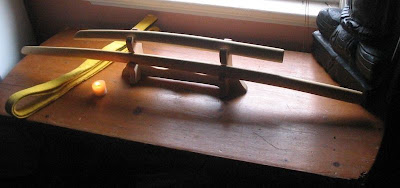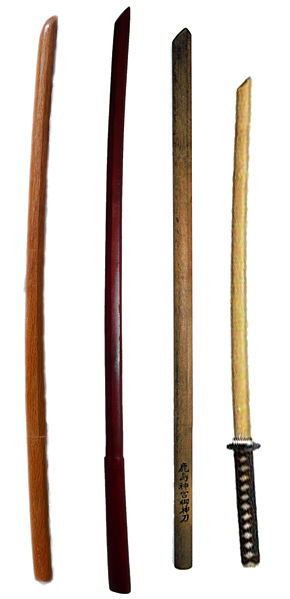
Bokken should not be confused with shinai, practice swords made of flexible bamboo.
HISTORY
Bokken were designed to lessen the damages caused by fighting with real swords and were used for the training of samurai warriors in feudal Japan. Bokken eventually became lethal weapons themselves in the hands of trained experts.
Miyamoto Musashi, a kenjutsu master, was renowned for fighting fully armed foes with only one or two bokken. In a famous legend, he defeated Sasaki Kojiro with a bokken he had carved from an oar while traveling on a boat to the predetermined island for the duel.
USAGE

In 2003, the All Japan Kendo Federation (AJKF) introduced a set of basic exercises using a bokuto called Bokuto Ni Yoru Kendo Kihon-waza Keiko-ho. This form of practice is intended primarily for kendoka up to Nidan, but can be beneficial for all kendo students.
Suburito are bokken designed for use in suburi. Suburi, literally "bare swinging," are solo cutting exercises. Suburito are thicker and heavier than normal bokken and users of suburito must therefore develop both strength and technique. Their weight makes them unsuitable for paired practice and kata. One famous user of the suburi-sized bokken is Miyamoto Musashi who used one in his duel against Sasaki Kojiro.
Bokken are currently issued to the Los Angeles Police Mounted Unit for use as batons.
TYPES OF BOKKEN
Bokken can be made to represent any style of weapon required such as nagamaki, no-dachi, yari, naginata, kama, etc. The most widely used styles are:
daitō or tachi (katana-sized), long sword
shoto or kodachi or wakizashi bo, short sword, (wakizashi-sized)
tantō bo (tantō-sized)
suburito can be made in daitō and shoto sizes
Additionally, various koryu (traditional Japanese martial arts) have their own distinct styles of bokken which can vary slightly in length, tip shape, or in whether or not a tsuba (hilt guard) is added.
The All Japan Kendo Federation specify the dimensions of bokken for use in the modern kendo kata, called Nippon kendo kata.
Tachi: Total length, approx. 102 cm; tsuka (handle) approx. 24 cm.
Kodachi: Total length, approx. 55 cm; tsuka (handle) approx. 14 cm.
CONSTRUCTION
 The type and quality of the wood, and the skill of the craftsman are critical factors in the manufacture of a good quality bokken. Almost all mass produced bokken are made from porous, loose-grained southeast Asian wood.[citation needed] These bokken may be easily broken when used in even light to medium contact drills and are best left for non contact work, such as in kata.[citation needed] Furthermore, the wood is often so porous, that if the varnish is stripped off the inexpensive bokken, one can see the use of wood fillers to fill the holes.
The type and quality of the wood, and the skill of the craftsman are critical factors in the manufacture of a good quality bokken. Almost all mass produced bokken are made from porous, loose-grained southeast Asian wood.[citation needed] These bokken may be easily broken when used in even light to medium contact drills and are best left for non contact work, such as in kata.[citation needed] Furthermore, the wood is often so porous, that if the varnish is stripped off the inexpensive bokken, one can see the use of wood fillers to fill the holes.While most species of North American red oak are unsuitable for construction of bokken, there are some Asian species of red oak that have a significantly tighter grain and will be able to withstand repeated impacts.
American white oak has been a proven staple over red oak due to its tighter grain structure. Another choice, hickory wood, seems to have a very good blend of hardness and impact resistance, while still having a relatively low cost. A few of the hardwoods that are used in American bokkens are the walnut, hickory, persimmon, oak and ironwood.
The use of exotic hardwoods is not unusual when constructing more expensive bokken. Bokken have been made from Brazilian cherrywood (Jatoba), others from purpleheart, and even from lignum vitae. Tropical woods are often quite heavy, a feature often desirable in a bokken despite the brittleness of these heavy and hard woods. Many exotic woods are suitable for suburi (solo practice), but not for paired practice where they would come into contact with other bokken.
Some online retailers offer bokken constructed from polypropylene plastics. The exact applications and benefits of such a weapon vary depending upon the user, as one such model has been demonstrated by its manufacturer to be capable of destroying concrete blocks and loading pallets.
-----------
http://en.wikipedia.org/wiki/Bokken


No comments:
Post a Comment